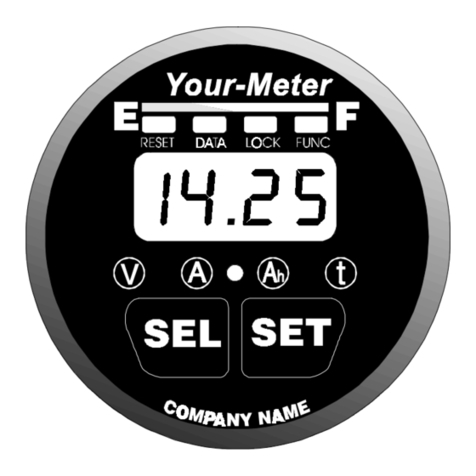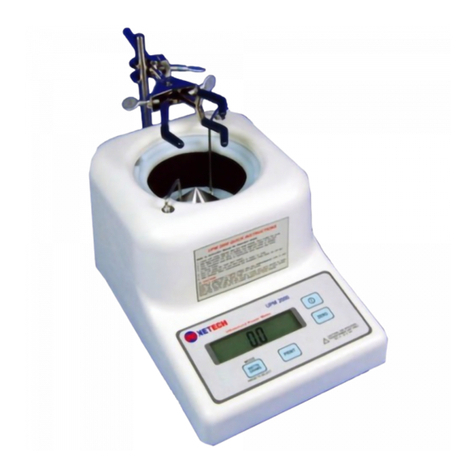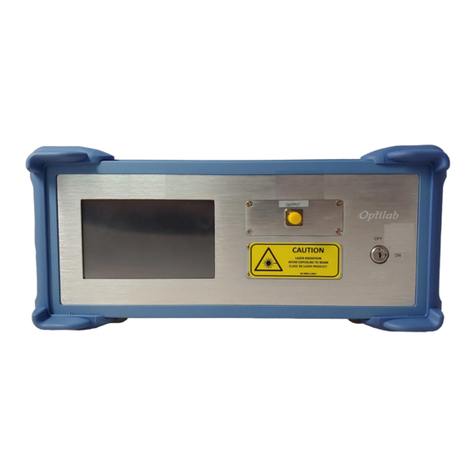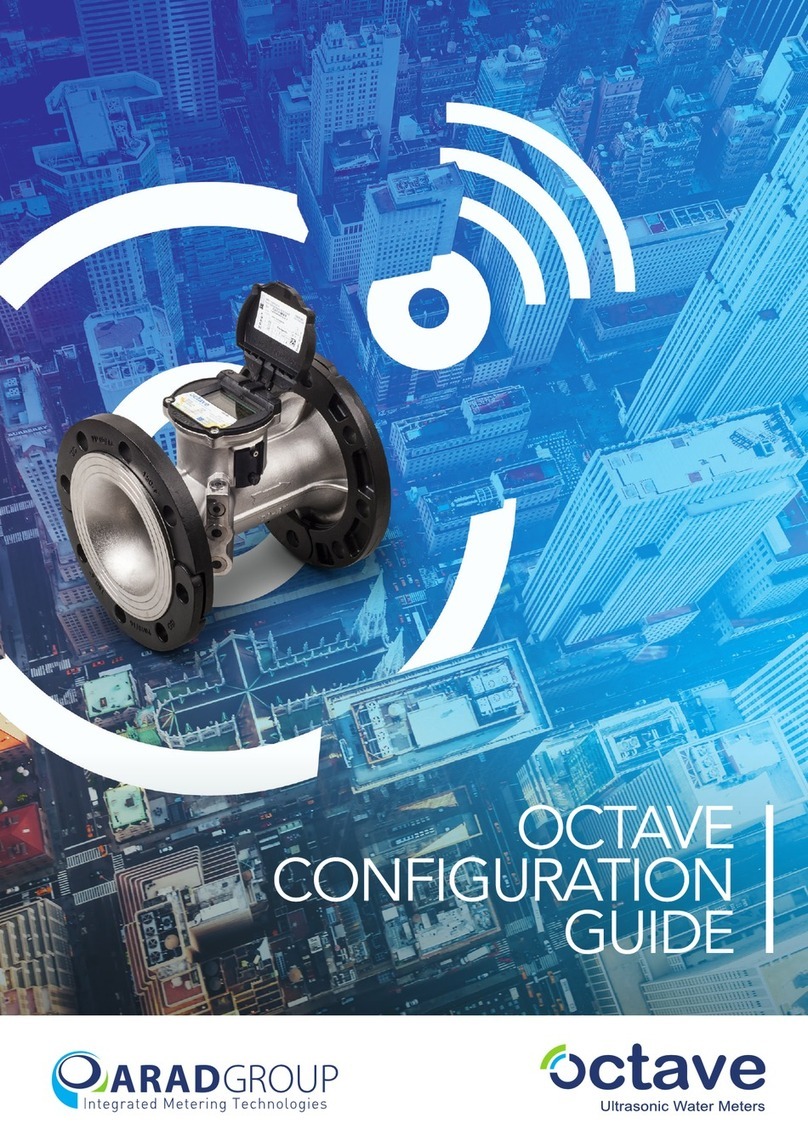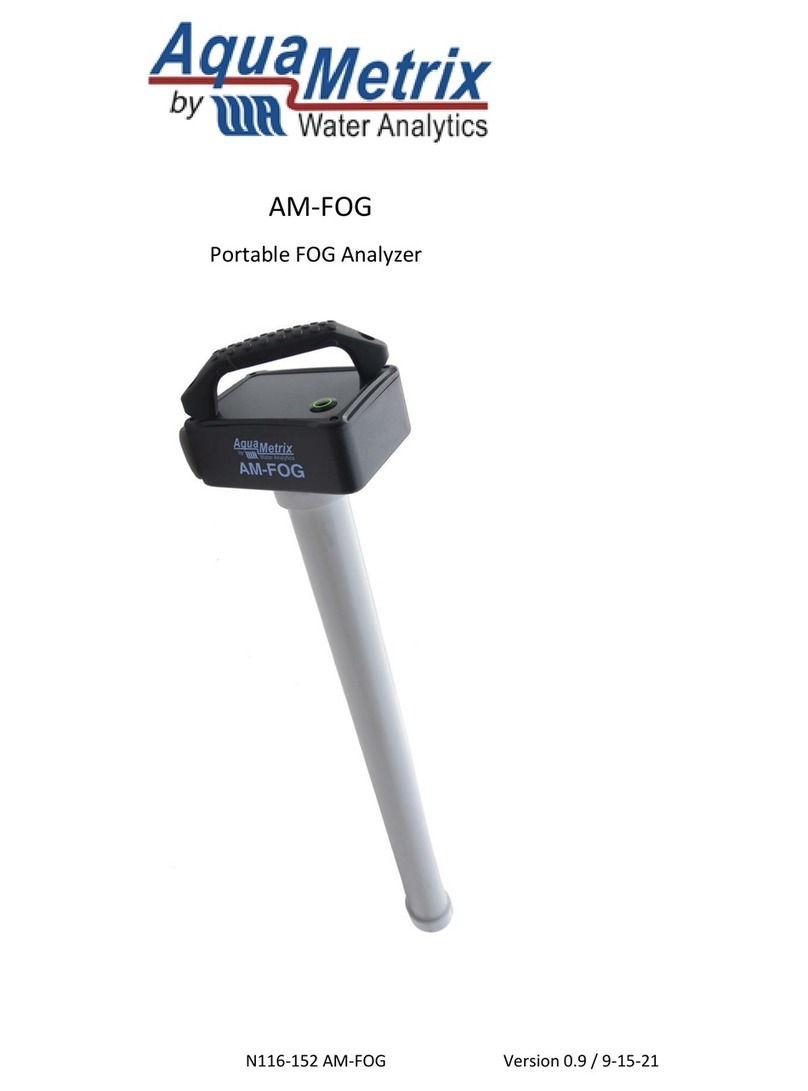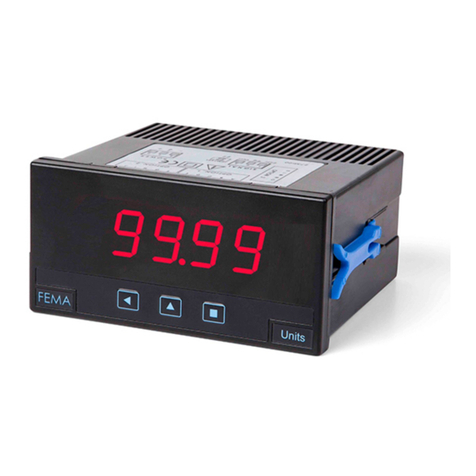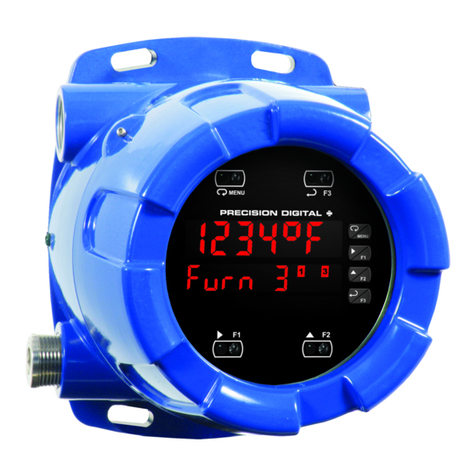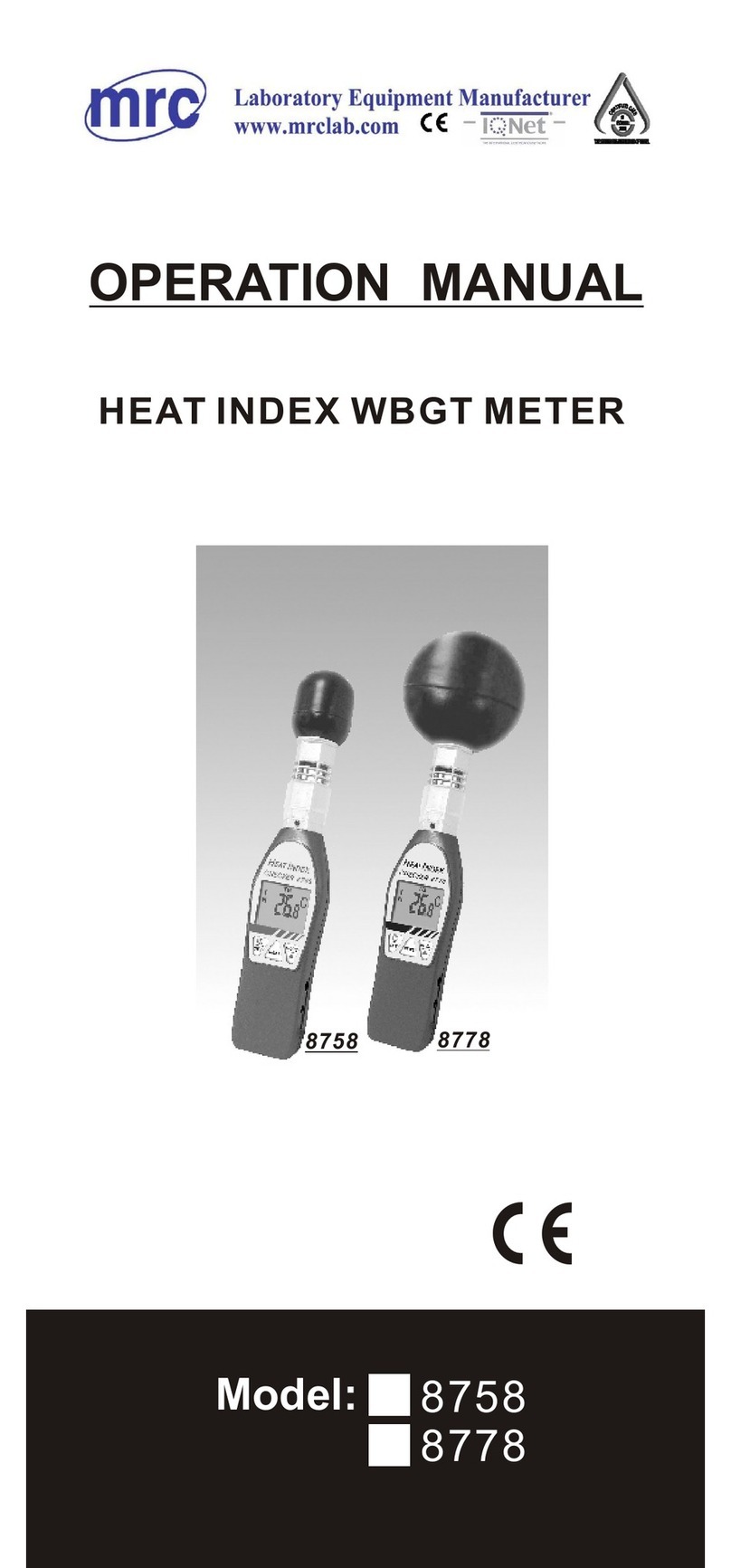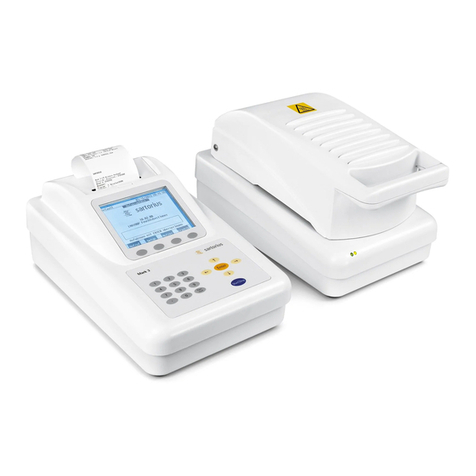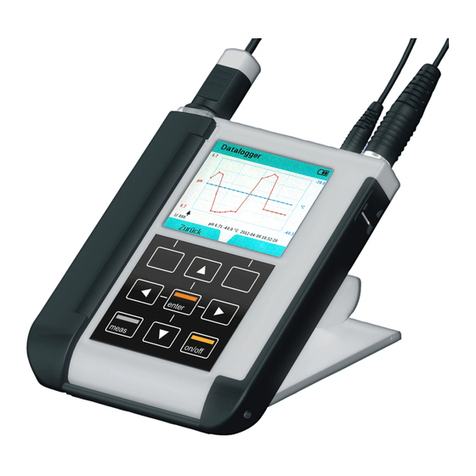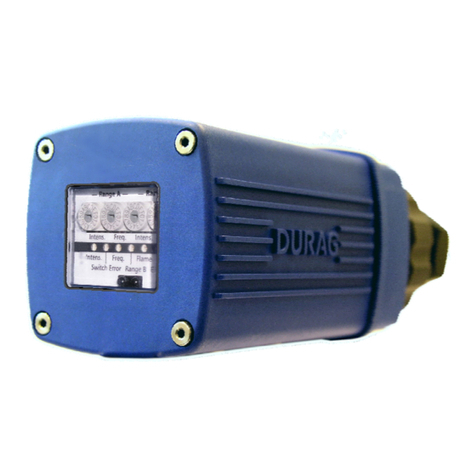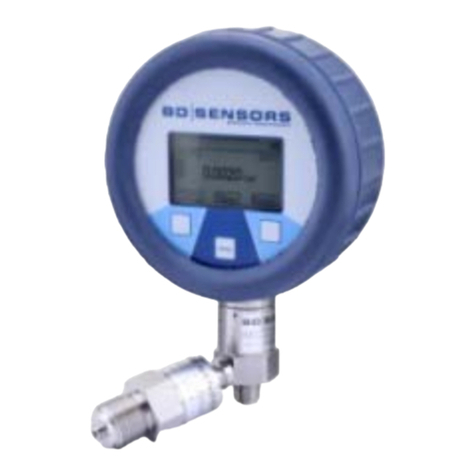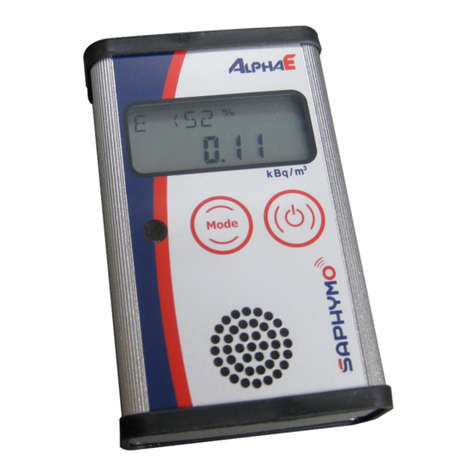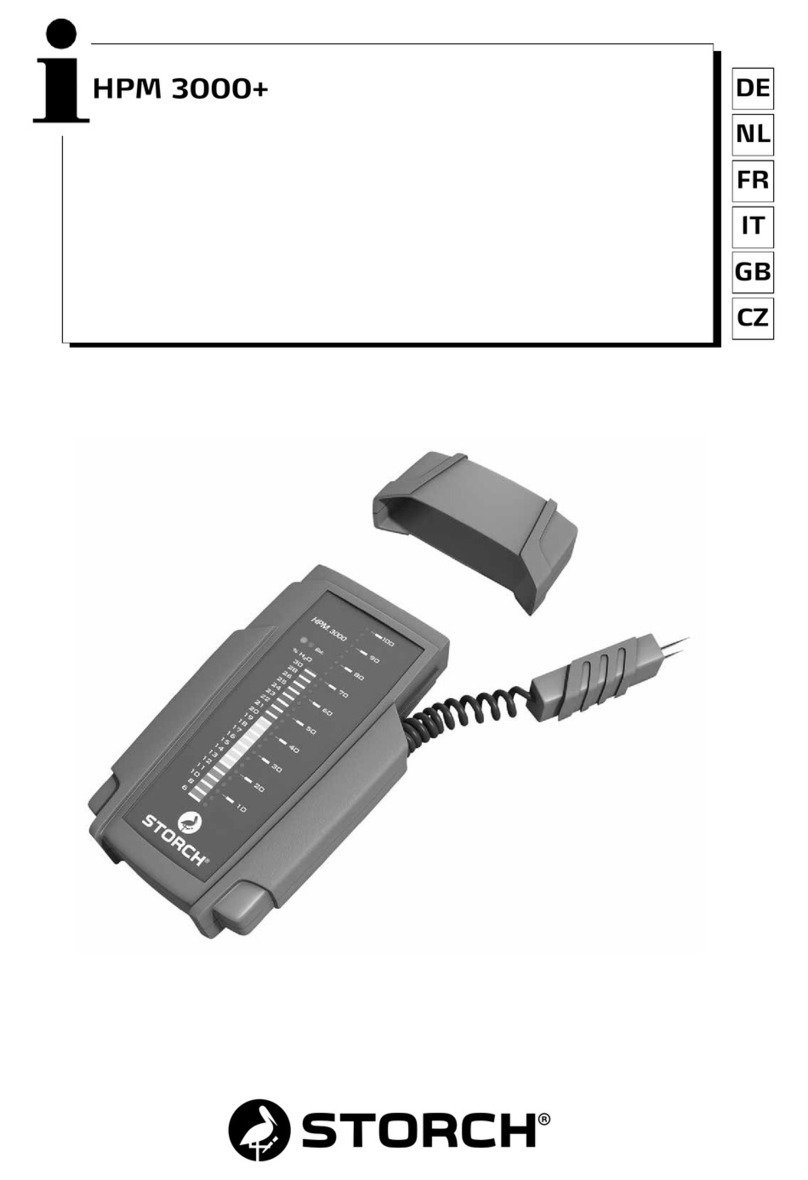Adwa Instruments AD1030 User manual

AD1030, AD1040, AD1200
pH /mV/ISE/Temperature
Bench Meters
www.adwainstruments.com
USER MANUAL
MANAD1040 R2 06/09
ADWA INSTRUMENTS Kft.
Alsókikötõ sor 11, 6726 Szeged, Hungary
Tel. +36 62 317 878
Fax +36 62 550 610
e-mail: [email protected]
www.adwainstruments.com

Dear Customer,
Thank you for choosing an Adwa product.
Please read carefully this manual before starting
operations.
This instrument is in compliance with the EMC Directive
89/336/EEC and Low Voltage Directive 73/23/EEC for
electrical equipments.
For additional technical information, please e-mail us at

3
TABLE OF CONTENTS
Introduction........................................................... 4
Technical Data ..................................................... 6
Front and Rear Panels .......................................... 8
Operational Guide ................................................13
pH Calibration .....................................................20
Relative mV Calibration .......................................29
ISE Calibration (AD1200 only)...........................................30
Good Laboratory Practice ....................................35
Setup ...................................................................42
Log-on-demand (AD1040 and AD1200) ............................48
Hold ....................................................................53
Temperature Calibration (for technical personnel only) .54
mV Calibration (for technical personnel only) ...................57
Analog Output .....................................................59
pH Electrode Conditioning & Maintenance ...........60
Electrodes, Probes and Solutions ..........................63
Troubleshooting Guide ..........................................64
Warranty .............................................................66
66
WARRANTY
Adwa warrants this product to be free of defects in
material and workmanship as stated in the operating
manual. If repair or adjustment is necessary and has
not been the result of abuse, misuse or improper han-
dling within the warranty period, please contact your
dealer or the nearest Adwa Office for the RGA
(Return Goods Authorization) number to put on the
outside of your package. Warranted service will be
made without charge.
The meter is warranted for a period of 2 years,
while probes are warranted for 6 months.
The warranty period commences from the original
date of sale.
Warranty is only valid when the product is used under
normal conditions and in accordance with the instruc
tion manual.
The warranty is void if the instrument is repaired or
serviced by unauthorized personnel, not used in accor-
dance to the instructions, or if non-Adwa accesso-
ries such as buffer solutions, probes, etc. are used
in conjunction with the meter. Adwa will not be
held responsible for any accident whether directly or
indirectly, caused by the use of this instrument.

4
INTRODUCTION
AD1030, AD1040 and AD1200 are professional
bench meters for pH, ORP (Oxidation Reduction Po-
tential), ISE (AD1200 only) and temperature
measurements. Relative mV readings are also pro-
vided. Main features include:
•Up to three-point calibration with seven memorized
buffers (pH 1.68, 4.01, 6.86, 7.01, 9.18, 10.01, 12.45)
and two custom buffers
•Calibration time-out alarm
•pH calibration using buffers with 0.001 resolution
•pH readings with manual or automatic temperature
compensation
•Up to 50 samples for log-on-demand (not for
AD1030)
•Two selectable alarm limits
•Large easy-to-read LCD showing the pH, ISE
(AD1200 only) or mV and temperature simulta-
neously, together with graphic symbols
•HOLD feature to freeze the stable reading on the
LCD
•GLP feature (not for AD1030) to view last calibra-
tion data for pH, ISE and relative mV ranges
65
SYMPTOM PROBLEM SOLUTION
The meter does Out of order Replace the probe.
not work with temperature probe.
temperature probe.
The meter fails to Broken or out of Replace electrode.
calibrate or gives order pH electrode.
faulty readings.
Explicit warnings Dirty/broken pH Follow displayed
are displayed electrode, instructions.
during pH contaminated
calibration. reference or buffers.
At start-up the One key is Check the keyboard
meter displays full blocked. or contact
LCD permanently. the vendor.
Long beep heard Key not working
when a key is in current mode.
pressed. End of range
reached with the
arrow keys.
Digits can not be Maximum value Delete digits.
introduced with reached for
the numeric keys. corresponding range.

5
Each model is supplied complete with:
•A1131B refillable pH electrode with glass body,
BNC connector and 1 m cable
•A7662 stainless steel temperature probe with 1 m
cable
•pH 4.01 and pH 7.01 calibration buffers (20 ml
sachet each)
•Electrode holder
•12 Vdc power adapter
•User manual
64
TROUBLESHOOTING GUIDE
SYMPTOM PROBLEM SOLUTION
Slow response/ Dirty pH Soak the electrode
excessive drift. electrode. tip in deionized water
for 30 min.
and then clean the
electrode .
Readings fluctuate Clogged/dirty Clean the electrode.
up and down junction. Low Refill with fresh
(noise). electrolyte level electrolyte (refillable
(refillable electrode only).
electrodes only).
The display shows Out of range in Make sure the pH
blinking dashes the pH scale. sample is in the
during pH specified range.
measurements. Recalibrate. Check
the electrolyte level
and the general state
of the pH electrode.
The display shows Reading out of Check the sample.
blinking reading range. Connect the electrode.
in measurement Electrode not
mode. connected.
Out of range in Dry membrane/ Soak in A7071S
the mV scale. junction. electrolyte solutionfor
at least one hour.

6
TECHNICALDATA
Range -2.00 to 16.00 pH / -2.000 to 16.000 pH
±2000 mV
0.001 to 19999 ppm (AD1200 only)
- 20.0 to 120.0°C (- 4.0 to 248.0°F)
Resolution 0.01 pH / 0.001 pH
0.1 mV
(±999.9) / 1 mV (outside) 0.001 ppm
(0.001 to 9.999) 0.01
ppm (10.00 to 99.99) 0.1
ppm (100.0 to 999.9) 1
ppm (1000 to 19999)
(AD1200 only)
0.1°C (0.1°F)
Accuracy ±0.01 pH / ±0.002 pH
(@20°C/68°F) ±0.2 mV up to ±699.9 mV
±0.5 mV up to ±999.9 mV
± 2 mV outside
± 0.5% f.s.
for ISE (AD1200 only) ±0.4°C
(±0.7°F) (excluding probe error)
Relative mV Offset ± 2000 mV
Analog Output ± 2000 mV
63
ELECTRODES, PROBES AND SOLUTIONS
A1131B Refillable pH electrode with glass body,
tip protection bottle, BNC connector
and 1 m cable
A1230B pH electrode with Epoxy body, tip pro-
tection bottle, BNC connector and 1
m cable
A3230B ORP electrode with Epoxy body, tip
protection bottle, BNC connector and
1 m cable
A7662 Stainless steel temperature probe with
1 m cable.
A70004P pH 4.01 buffer, 20 ml sachet, 25 pcs
A70007P pH 7.01 buffer, 20 ml sachet, 25 pcs
A70010P pH 10.01 buffer, 20 ml sachet, 25 pcs
A7071S 3.5 M KCl + AgCl electrolyte solu-
tion for refillable electrodes, 30 ml
bottle

7
pH Calibration Up to 3 point calibration,
with 2 custom and 7 standard buffers
(pH 1.68, 4.01, 6.86, 7.01, 9.18, 10.01, 12.45)
ISE Calibration Up to two-point calibration,
(AD1200 only) 5 standard solutions available
(0.1,1,10,100,1000 ppm)
Temperature Manual or automatic,
Compensation -20.0 to120.0°C (-4.0 to 248.0°F)
pH Electrode A1131B
Temperature Probe A7662
Input Impedance 1012 Ohm
Log-on-demand Up to 50 samples
(AD1040 & AD1200)
Environment 0 to 50°C (32 to 122°F)
RH max. 95% non-condensing
Power Supply 12 Vdc adapter
Dimensions 230 x 180 x 50 mm
Weight 1.8 kg
62
Refill the electrode reference chamber with fresh
A7071S electrolytesolution.Allow theelectrodeto stand
upright for 1 hour. Follow the storage procedure above.
CLEANING PROCEDURE
Soak in deionized water for approximately 30 minutes.
IMPORTANT: After performing any of the cleaning
procedures, rinse the electrode thoroughly with deion-
ized water, refill the reference chamber with fresh elec-
trolyte and soak the electrode in A7071S electrolyte
solution for at least 1 hour before taking measurements.

8
Keyboard for AD1030
FRONT AND REAR PANELS
1. HOLD key, to freeze the stable reading on the LCD
2. Numerical keys only
3. ON/OFF key, to turn the instrument ON and OFF
4. Right arrow key, to toggle between parameters
while in SETUP mode (forwards), to toggle between
absolute mV and temperature while in relative mV
mode and between pH buffer and temperature while
in pH calibration mode
61
For refillable electrodes:
If the filling solution (electrolyte) is more than 2.5 cm
below the fill hole, add A7071Selectrolyte solution.
For faster response, unscrew the fill hole screw during
measurements.
STORAGE PROCEDURE
To minimize clogging and assure a quick response time,
the glass bulb and the junction of the pH electrode should
be kept moist and not allowed to dry out.
Replace the solution in the protective cap with a few
drops of A7071Selectrolyte solution.
NEVER STORE THE ELECTRODE IN DISTILLED
OR DEIONIZED WATER.
PERIODIC MAINTENANCE
Inspect electrode and cable. The cable used for con-
nection to the instrument must be intact and there must
be no points of broken insulation on the cable or cracks
on the electrode stem or bulb. Connectors must be per-
fectly clean and dry. If any scratches or cracks are
present, replace the electrode. Rinse off any salt depos-
its with water.
For refillable electrodes:

9
5. Up arrow key, to manually increase temperature
value or other parameters
6. CLEAR key, to clear calibration data
7. RANGE key, to select measurement unit or switch
focused data
8. SHIFT key, to activate the second function key
9. NUM LOCKkey, to active numerical keys (0 to 9, ±)
10. Down arrow key, to manually decrease tempera-
ture value or other parameters
11. CFM key, to confirm values
12. CAL/SETUP key, to enter/exit calibration mode and
to enter/exit SETUP mode
13. Left arrow key,to togglebetweenparameterswhile
in SETUP mode (backwards), to toggle between ab-
solute mV and temperature while in relative mV
mode and between pH buffer and temperature while
in pH calibration mode
Note:To select second function, press first SHIFT and
then the desired key. The SHIFT tag will appear
on the LCD until the desired key is pressed.
To leave second function mode, press SHIFT
again.
60
pH ELECTRODE CONDITIONING &
MAINTENANCE
PREPARATION PROCEDURE
Remove the pH electrode protective cap. DO NOT BE
ALARMED IF SALT DEPOSITS ARE PRESENT.
This is normal with electrodes and they will disappear
when rinsed with water.
During transport, tiny bubbles of air may form inside the
glass bulb affecting proper functioning of the electrode.
These bubbles can be removed by “shaking down” the
electrode as you would do with a glass thermometer.
If the bulb and/or junction are dry, soak the electrode in
A7071S electrolyte solution for at least one hour.

10
1. HOLD key, to freeze the stable reading on the LCD
2. Numerical keys only
3. ON/OFF key, to turn the instrument ON and OFF
4. Right arrow key, to toggle between parameters
while in SETUP mode (forwards), to toggle between
absolute mV and temperature while in relative mV
mode and between pH buffer and temperature while
in pH calibration mode
Keyboard for AD1040 and AD1200
59
ANALOG OUTPUT
For the full range of each measurement, the analog out-
put varies from - 2000 to 2000 mV.

11
5. Up arrow key, to manually increase temperature
value or other parameters
6. CLEAR key, to clear calibration data
7. RANGE key, to select measurement unit or switch
focused data
8. SHIFT key, to activate the second function key
9. NUM LOCKkey, to active numerical keys (0 to 9, ±)
10. Down arrow key, to manually decrease tempera-
ture value or other parameters
11. MEMRCL key, to recall stored value
12. CFM/GLP key,toconfirmvaluesandviewGLPdata
13. STORE key, to store readings (log-on-demand)
14. CAL/SETUP key, to enter/exit calibration mode and
to enter/exit SETUP mode
15. Left arrow key,to togglebetweenparameterswhile
in SETUP mode (backwards), to toggle between ab-
solute mV and temperature while in relative mV
mode and between pH buffer and temperature while
in pH calibration mode
Note:To select second function, press first SHIFT and
then the desired key. The SHIFT tag will appear
on the LCD until the desired key is pressed. To
leave second function mode, press SHIFT again.
58
•Set the simulator to 600.0 mV. When the reading is
stable and close to the selected calibration point, the
CFM tag starts blinking.
•Press CFM to confirm. The secondary LCD will dis-
play the third expected value (1800 mV).
•Set the simulator to 1800.0 mV. When the reading is
stable and close to the selected calibration point, the
CFM tag starts blinking.
•Press CFM to confirm. The instrument returns to mea-
surement mode.
Notes:
•If the reading is not close to the selected point,
the WRONG tag will blink. Verify the calibra-
tion conditions or contact your dealer if calibra-
tion can not be performed.
•To return to normal measurement mode, press
CAL at any moment during calibration.
•If the calibration procedure is ended after the
600.0 mV point is confirmed, the meter returns
to normal measurement mode and stores a 2-
point calibration data.

12
Front Panel
Rear Panel
1. Power adapter socket
2. Reference input socket
3. BNC connector for pH, ISE and ORP electrodes
4. Temperature probe socket
5. Analog output sockets
57
mV CALIBRATION (for technical personnel only)
The instruments are factory calibrated for mV range.
Adwa’s ORP electrodes are interchangeable and no mV
calibration is needed when they are replaced.
If measurements are not accurate, a mV recalibration
should be performed.
For an accurate recalibration, contact your dealer or the
nearest Adwa Customer Service Center, or follow the
instructions below.
A two or three-point procedure can be performed at 0.0,
600.0 and 1800.0 mV.
•Attach a mV simulator with an accuracy of ±0.1 mV
to the BNC connector on the rear panel.
•With the instrument off, press and hold the CFM &
STORE keys, then power on the instrument.
The CAL tag lights up and the secondary LCD shows
0.0 mV.
•Set the simulator to 0.0 mV. When the reading is stable
and close to the selected calibration point, the CFM
tag starts blinking.
•Press CFM to confirm and the secondary LCD will
display the second expected value (600.0 mV).

OPERATIONAL GUIDE
CONNECTIONS
•Plug the 12 Vdc adapter into the power supply socket.
Note:These instruments feature a non-volatile memory
to keep calibration data and all meter settings
even when unplugged.
•Attach the pH, ISE (AD1200 only) or ORP electrode
and the temperature probe to the appropriate sockets
on the rear panel. For electrodes with separate refer-
ence, connect the reference to the proper input socket.
•Attach the analog output to the proper connectors on
the back of the instrument.
•Press CFM to confirm. The instrument
returns to normal measurement mode.
Note: If the reading is not close to the selected cali-
bration point, the WRONG tag will blink. Change
the temperature probe and restart calibration.
13
56

•Immerse the temperature probe into the vessel with
ice and water as close as possible to the reference
thermometer. Allow a few seconds for probe thermal
stabilization.
•Use the arrow keys to set the reading on the second-
ary LCD to that measured by the reference thermom-
eter.
•When the reading is stable and close to the selected
calibration point, the CFM tag starts blinking.
•Press CFM to confirm. The secondary
LCD will display 50.0°C (or 122.0°F).
•Immerse the temperature probe into the second ves-
sel as close as possible to the reference thermometer.
Allow a few seconds for probe thermal stabilization.
•Use the arrow keys to set the reading on the second-
ary LCD to that of the hot water measured by the
reference thermometer.
•When the reading is stable and close to the selected
calibration point, the CFM tag starts blinking.
INSTRUMENT START-UP
Turn the instrument on by pressing the ON/OFF button.
All LCD tags are displayed and a beep is heard (if beep
is ON) while the instrument performs a self test.
The instrument will display the date on the primary LCD
and the time on the secondary LCD, and then it will
enter the same measurement range as it was at power
off.
pH MEASUREMENTS
Make sure the instrument has been calibrated before
taking pH measurements.
•Press RANGE to enter pH range.
Press RANGE again to change the pH
measurement resolution.
14 55

•Immerse pH electrode tip and tempera-
ture probe approximately 4 cm into the
solution to be tested. Allow for the elec-
trode to stabilize and put the tempera-
ture probe tip as close as possible to the
pH electrode.
•The pH reading is displayed on the primary LCD and
the temperature value on the secondary LCD.
•If measurements are taken successively in different
samples, it is recommended to rinse the electrode thor-
oughly with deionized or tap water and then with some
of the next sample. This will prevent cross contami-
nations and condition the electrode before immersing
it into the solution to be tested.
•The pH reading is affected by temperature. In order
to measure the pH accurately, the temperature effect
must be compensated for.
15
54
TEMPERATURE CALIBRATION
(for technical personnel only)
The instruments are factory calibrated for temperature.
Adwa’s temperature probes are interchangeable and no
temperature calibration is needed when they are replaced.
If temperature measurements are not accurate, tempera-
ture new calibration should be performed.
For an accurate recalibration, contact your dealer or the
nearest Adwa Customer Service Center, or follow the
instructions below.
•Prepare a vessel containing ice and water, and an-
other one containing hot water at approximately 50°C
(122°F). Place insulation material around the vessels
to minimize temperature drift.
•Use a calibrated thermometer with a resolution of 0.1°C
(or 0.1°F) as reference thermometer. Connect the
supplied A7662 temperature probe to the appropriate
socket on the rear panel.
•With the instrument off, press and hold the CAL & up
arrow keys, then power on the instrument. The “CAL”
tag lights up and the secondary LCD shows 0.0°C (or
32.0°F). The primary LCD will display the measured
temperature or “----”, if the reading is out of range.

HOLD
To freeze a stable reading on the LCD, press HOLD
key from normal measurement mode.
The “Auto” and “H” tags will blink on the LCD until the
reading stabilizes.
When the reading is stable, the “Auto” and “H” tags
stop blinking and the reading is frozen.
Press HOLD key again to return the normal measure-
ment mode.
Note: Pressing RANGE the instrument will skip to the
displayed range, without leaving the HOLD
mode. The STORE key also holds HOLD mode.
Pressing MEM RCL key, SHIFT and then
SETUP or GLP, the instrument leaves the HOLD
mode and performs the selected function.
16
To use the ATC (Automatic Temperature Compensa-
tion) capability of the instrument, connect the A7662
temperature probe, immerse it into the sample as close
as possible to the pH electrode and wait for a few
seconds.
•If the sample solution temperature is known, MTC
(Manual Temperature Compensation) can be per-
formed by disconnecting the temperature probe. The
display will show the default temperature of 25°C (or
77°F) or the last temperature reading with the °C (or
°F) tag blinking.
•The temperature can be adjusted using the arrow keys
from -20.0 to 120.0°C (or from -4.0 to 248.0°F).
53

ORP (mV) MEASUREMENTS
Oxidation-reduction potential (REDOX) measurements
provide the quantification of the oxidizing or reducing
power of the tested sample.
To correctly perform a redox measurement, the surface
of the ORP electrode must be clean and smooth.
•Press RANGE to enter the mV range.
•Immerse the ORP electrode tip 4 cm into
the solution to be tested and wait a few
seconds for the reading to stabilize.
•The instrument displays the mV reading on the pri-
mary LCD and the temperature on the secondary LCD.
•If reading is out of range, the closest full-scale value
will blink on the primary LCD.
17
52
Note: Pressing SHIFT and then SETUP key, the in-
strument toggles between lot and record num-
ber or all lots.
•Press CLEAR to delete the selected lot/record or all
lots.
Note: Positions remain free in the log-on-demand lot
by deleting the last logged sample or all lots.
•If the “dEL All” option was selected, all logged data
are deleted and the instrument returns to normal mea-
surement mode.
•Press MEMRCL at any time to return to measure-
ment mode.

51
RELATIVE mV MEASUREMENTS
To enter relative mV mode, press RANGE. The relative
mV reading will be displayed on the primary LCD and
the current temperature value on the secondary LCD.
Note: Press the right or left arrow key to toggle be-
tween temperature and absolute mV reading on
the secondary LCD.
The relative mV reading is equal to the difference be-
tween the absolute mV input value and relative mV off-
set established in the relative mV calibration.
18
Press RANGE or right arrow key to scroll all logged
parameters, displayed as shown in the table below:
Parameter Primary LCD Secondary LCD
mV mV reading Temperature
TIME Hour & minutes Seconds
DATE Year Month & day
OFFSET Offset value “LdM” orrecord number
SLOPE Slope value “LdM” or
ion charge (ISE range)
Notes:
•To view the previous logged parameter, press
the left arrow key.
•In relative mV memory recall mode, the offset
value is not available and the display shows
dashes “----”.
•The record number is an identification number
for the logged sample.
After scrolling all logged pa-
rameters, the meter displays
the “dEL” message together
with the “LdM” indication.

TEMPERATURE MEASUREMENTS
Connect the A7662 temperature probe to
the appropriate socket, immerse the probe
into the solution and allow the reading to
stabilize.
Note: Thetemperature can bedisplayedinCelsius(°C)
or Fahrenheit (°F) degrees (see “Setup” section
for details).
ISE MEASUREMENTS (AD1200 only)
To measure the ion concentration, enter
the ISE mode by pressing RANGE.
•Immerse the tip of the ISE electrode 4
cm into the solution to be tested and
wait a few seconds for stable reading.
•The instrument will display the ppm
reading on the primary LCD and the
temperature on the secondary LCD.
VIEWING LOGGED DATA
To retrieve the information stored, press MEMRCL from
measurement mode. If no data were logged, the “no rEC”
message blinks on the LCD.
Otherwise, the instrument displays the memorized pH,
relative mV or ppm (AD1200 only) reading, and the lot
number.
Pressing SHIFT and then SETUP key while in memory
recall mode, the secondary LCD will toggle between
the “LdM” indication and the record number. Use the
arrow keys to select a different record.
19
50

20
pH CALIBRATION
The instrument should be recalibrated:
•Whenever the pH electrode is replaced
•At least once a week
•After testing aggressive chemicals
•If the “CAL DUE” message is blinking during mea-
surement
PREPARATION
Pour small quantities of the buffer solutions into clean
beakers. If possible, use plastic or glass beakers to mini-
mize any EMC interferences.
For accurate calibration and to minimize cross-contami-
nation, use two beakers for each buffer solution: the first
one for rinsing the electrode and the second for calibra-
tion.
If you are measuring in the acidic range, use pH 4.01 or
1.68 as second buffer. If you are measuring in the alka-
line range, use 10.01/9.18 or 12.45 as second buffer.
For extended range measurements (acidic and alkaline),
perform a three-point calibration by selecting three of
the available buffers.
49
If there are less than 6 memory locations left, the record
number and the “Lo” message will blink for a few sec-
onds to alert the user, and then the number of free loca-
tions is displayed.
If the logging space is full, the “FULL LOC” message
will be displayed for a few seconds together with the
“LOG” tag blinking, followed by the “FrEE 0” message.
The instrument returns to normal measurement mode.
This manual suits for next models
2
Table of contents
